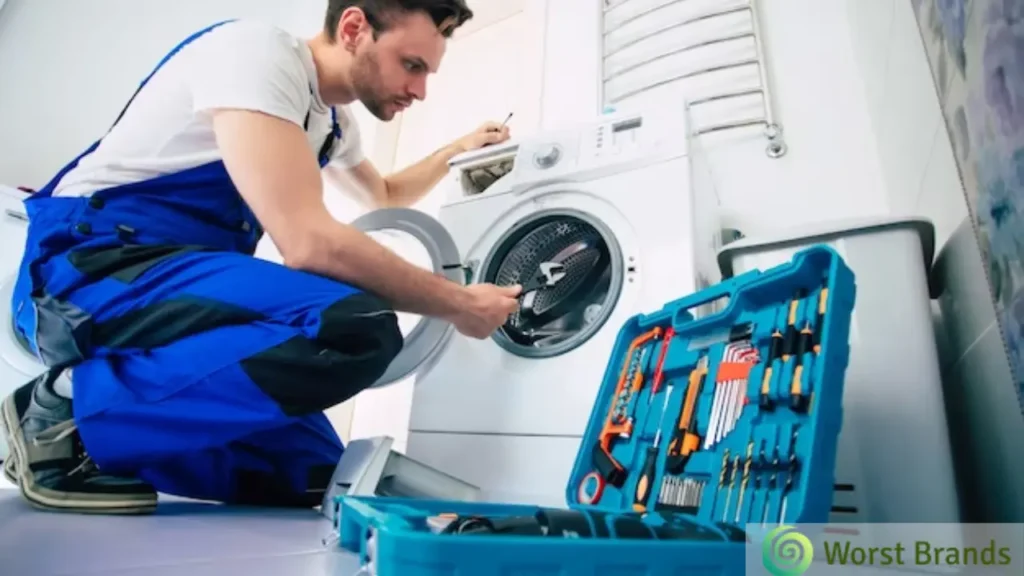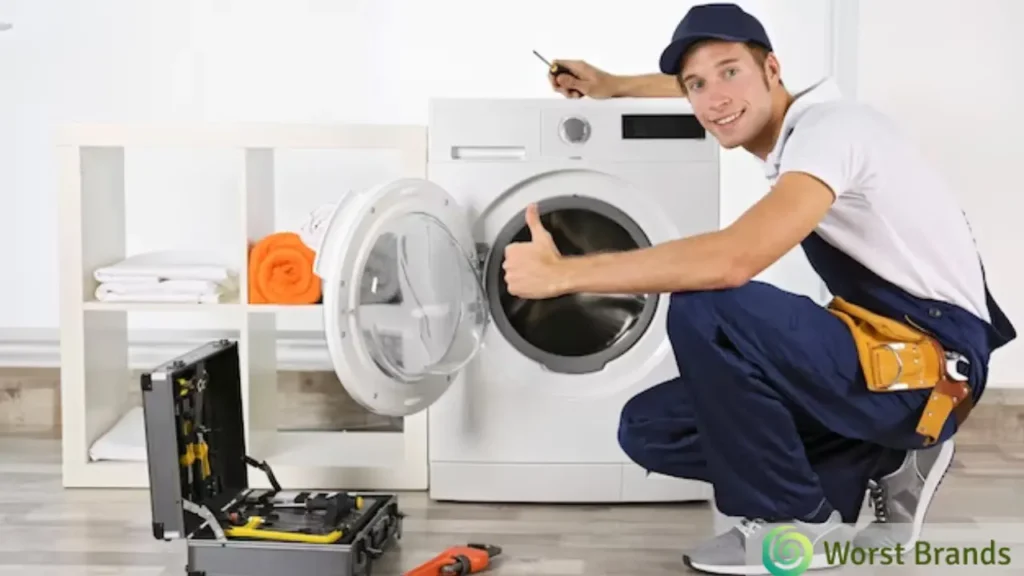Roper washing machines are carving a niche in the home appliance industry, known for their reliability and efficiency.
However, like any appliance, they can run into issues, one of the most common being the washer not spinning. This problem can disrupt your laundry routine, leaving you with a tub full of wet clothes.
Understanding why your Roper washer not spinning and how to fix it is crucial for a quick resolution.
Common reasons your Roper washing machine won’t spin include a failed motor coupling, worn-out drive belt, damaged drive motor, faulty door lock, and a few others.
Table of Contents
How to Fix Roper Washing Machine Won’t Spin?

Discovering your Roper washing machine won’t spin can be frustrating. Fortunately, most causes have straightforward fixes you can manage without professional help. So, let’s start troubleshooting.
1. Failed Motor Coupling
The motor coupling is a key component that connects the motor to the washer’s transmission.
Overloading your Roper washing machine can cause undue stress on the motor coupling, leading to wear or even breakage.
This directly affects the washer’s ability to spin, as the transmission no longer receives the necessary power from the motor.
Easy Fix:
Inspect the motor coupling for any signs of damage. If you find it broken, replacing it is the next step.
This repair is moderately challenging but doable for those with some DIY skills.
Remember, prevention is key – avoid overloading your washer to prevent future coupling failures.
Regular maintenance checks can also help identify issues before they escalate.
2. Worn-Out Drive Belt
The drive belt is crucial for the spinning motion of your Roper washer.
Over time, this belt can become loose, break, or slip off the pulleys, especially with heavy usage.
A compromised drive belt means your Roper washer’s drum won’t spin even though the motor runs.
Easy Fix:
Inspect the belt for any signs of wear or damage. If the belt is loose but intact, try reattaching it to the pulleys.
In cases where the belt is overstretched or broken, replacement is the only solution.
Replacing a drive belt is manageable for those familiar with appliance repairs.
Make sure to purchase the correct belt model for your Roper washer. Carefully follow the washer’s manual.
3. Damaged Drive Motor
The drive motor in your Roper washing machine plays a pivotal role in its operation. When functioning properly, it powers the machine’s spin cycle.
However, if the motor malfunctions, it can halt the spinning process entirely.
This issue might not be immediately apparent, as drive motor problems can develop gradually.

Easy Fix:
Begin by visually inspecting the motor. Look for any signs of physical damage, such as burnt wires or worn components.
If the motor makes no sound or emits excessive noise when activated, it strongly indicates a malfunction.
Replacing a drive motor is intricate and usually beyond the scope of DIY repairs. In this case, seeking assistance from a qualified technician is recommended.
They can accurately diagnose the issue and ensure a safe and effective replacement.
4. Defective Door Lock Motor
The door lock motor and switch assembly ensure the washer door is securely closed during operation.
If this mechanism fails, it can trick the washer into thinking the door is open, preventing the spin cycle from initiating.
Easy Fix:
Start fixing the Roper washer that is not spinning by examining the door lock for any visible damage or wear.
Sometimes, the issue may stem from an electrical problem within the lock mechanism.
Using a multimeter, check the switches for continuity to determine if an electrical failure is present.
If you find the lock is mechanically or electrically defective, replacing it is often straightforward.
However, if you’re not comfortable working with electrical components, it’s wise to consult a professional.
When replacing the door lock, ensure you get the right part for your specific Roper model to guarantee compatibility and proper function.
5. Faulty Lid Switch
The lid switch assembly is a safeguard in your Roper washing machine, designed to prevent the machine from spinning when the lid is open.
A malfunction in this assembly can mimic the effect of an open lid, thus stopping the Roper washing machine’s spin cycle. This issue is particularly common in top-loading models.
Easy Fix:
Testing the lid switch assembly for continuity with a multimeter is your first step.
If the test shows no continuity, the switch is defective and needs replacement.
While replacing the lid switch is generally straightforward, ensuring the new switch is compatible with your model is crucial.
Remember, safety first: disconnect the washer from power before attempting any repairs.
6. Worn Rotor Assembly
In a Roper washing machine, the rotor assembly creates the magnetic field for the drum to spin.
Damage to this component can lead to a complete halt in the Roper washer’s spinning action.
Such damage might be due to natural wear and tear or external factors like power surges or mechanical impact.
Easy Fix:
Assess the rotor for visible signs of damage. This might include cracks, burn marks, or any form of deformation.
Replacing a rotor is not straightforward; it requires a certain level of technical expertise. If you’re uncomfortable to handle such repairs, it’s wise to call in a professional.
7. Damaged Stator Assembly
In conjunction with the rotor, the stator creates the magnetic field that drives the spinning motion in your Roper washer.
A damaged stator can disrupt this field, leading to a non-spinning Roper washer’s drum.
Stator damage could be due to various factors, including electrical issues or mechanical wear.

Easy Fix:
Diagnosing and replacing a stator requires a deep understanding of the washer’s electrical system.
Due to the complexity and potential risks involved, it’s advisable to enlist the help of a qualified technician.
They can safely assess the stator’s condition and perform a replacement if necessary.
Regular maintenance and avoiding overloading can help prolong the life of your washer’s stator.
8. Bad Transmission
The transmission in your Roper washing machine is like the gearbox in a car. It’s essential for shifting the machine from wash to spin cycle.
It can stop the Roper washer from spinning when it wears out or breaks. This can be a result of age, overuse, or mechanical failure.
Easy Fix:
Diagnosing transmission issues requires a professional’s expertise. Check for any unusual noises during the wash cycle, which can indicate transmission problems.
If you suspect a transmission issue, contact a skilled appliance repair technician. They can determine if the transmission needs repair or replacement.
9. Motor Control Board Malfunction
The motor control board is the brain of your Roper washing machine, governing its motor functions.
When this board is damaged, it can disrupt the power supply to the motor, making the spin cycle inoperative.
Causes for damage can range from power surges to general wear and tear.
Easy Fix:
Begin troubleshooting the Roper washer by inspecting the control board for any visible signs of damage like burn marks or blown capacitors. If you find any defects, the control board must be replaced.
Given this task’s complexity and electrical nature, I suggest seeking professional assistance.
Final Words
In wrapping up, troubleshooting a Roper washer won’t spin problem doesn’t have to be a headache.
This guide has walked you through various scenarios, pinpointing potential causes and providing practical solutions.
Adhering to these steps will solve immediate issues and contribute to your washer’s overall health and longevity.
With a bit of attention and care, you can keep your Roper washer running smoothly, ensuring that your laundry days remain hassle-free.
Check out the following blogs if you are facing a spinning problem but have a different washer brand:
- Bosch Washer Not Spinning – Quick & Easy Repair Guide
- Troubleshooting Hotpoint Washer Not Spinning
- How to Fix GE Washer Not Spinning

Steven Settles is an ISCET-certified master in appliance repair. He has aced the National Appliance Service Technician Certification Exam, showcasing his exceptional diagnostic and repair skills. With an in-depth understanding of the latest repair technologies and a keen eye on evolving industry standards, Steven is a go-to expert for any appliance issue.